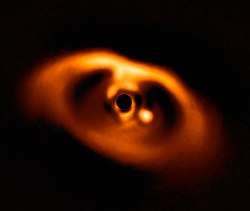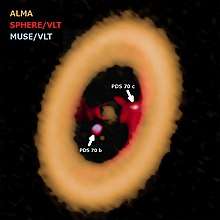PDS 70
PDS 70 (V1032 Centauri) is a low-mass T Tauri star in the constellation Centaurus. Located approximately 370 light-years from Earth, it has a mass of 0.82 M☉,[2] and is approximately 10 million years old.[5] The star has a protoplanetary disk containing two nascent exoplanets, named PDS 70b and PDS 70c, which have been directly imaged by the European Southern Observatory's Very Large Telescope. PDS 70b was the first confirmed protoplanet to be directly imaged.[6][7][8]
 | |
| Observation data Epoch J2000 Equinox J2000 | |
|---|---|
| Constellation | Centaurus |
| Right ascension | 14h 08m 10.15451s[1] |
| Declination | −41° 23′ 52.5766″[1] |
| Apparent magnitude (V) | 12[2] |
| Characteristics | |
| Spectral type | K5[3] |
| U−B color index | 0.71[4] |
| B−V color index | 1.06[4] |
| Astrometry | |
| Radial velocity (Rv) | 3.13[1] km/s |
| Proper motion (μ) | RA: -29.661[1] mas/yr Dec.: -23.823[1] mas/yr |
| Parallax (π) | 8.8159 ± 0.0405[1] mas |
| Distance | 370 ± 2 ly (113.4 ± 0.5 pc) |
| Details | |
| Mass | 0.82[2] M☉ |
| Radius | 1.39[4] R☉ |
| Temperature | 4406[4] K |
| Rotation | ~50 days[3] |
| Rotational velocity (v sin i) | ~10[3] km/s |
| Other designations | |
| Database references | |
| SIMBAD | data |
Protoplanetary disk

The protoplanetary disk around PDS 70 was first hypothesized in 1992[9] and confirmed in 2006 along with a jet-like structure.[2] The disk has a radius of approximately 140 au. In 2012 a large gap (~65 au) in the disk was discovered, which was thought to be caused by planetary formation.[3][5]
The gap was later found to have multiple regions: large dust grains were absent out to 80 au, while small dust grains were only absent out to the previously-observed 65 au. There is an asymmetry in the overall shape of the gap; these factors indicate that there are likely multiple planets affecting the shape of the gap and the dust distribution.[10]
In results published in 2018, a planet in the disk, named PDS 70b, was imaged by the Very Large Telescope (VLT).[7][8] With a mass estimated to be a few times greater than Jupiter, the planet is thought to have a temperature of around 1000 °C and an atmosphere with clouds; its orbit has an approximate radius of 3.22 billion kilometres (21.5 au), taking around 120 years for a revolution. Modelling predicts that the planet has acquired its own accretion disk.[6][11] The accretion disk was observationally confirmed in 2019,[12] and accretion rate was measured to be at least 5*10-7 Jupiter masses per year.[13]
A second planet, named PDS 70c, was discovered in 2019 using the VLT's MUSE integral field spectrograph.[14] The planet orbits its host star at a distance of 5.31 billion kilometres (35.5 au), further away than PDS 70b.[14] PDS 70c is in a near 1:2 orbital resonance with PDS 70b, meaning that PDS 70c completes nearly one revolution once every time PDS 70b completes nearly two.[14]
Circumplanetary disk
In July 2019 astronomers using the Atacama Large Millimeter Array (ALMA) reported the first-ever detection of a moon-forming circumplanetary disk. The disk was detected around PDS 70c, with a potential disk observed around PDS 70b.[15][16][17] The disk was confirmed by Caltech-led researchers using the W. M. Keck Observatory in Mauna Kea, whose research was published in May 2020.[18]
References
- Brown, A. G. A.; et al. (Gaia collaboration) (August 2018). "Gaia Data Release 2: Summary of the contents and survey properties". Astronomy & Astrophysics. 616. A1. arXiv:1804.09365. Bibcode:2018A&A...616A...1G. doi:10.1051/0004-6361/201833051.
- Riaud, P.; Mawet, D.; Absil, O.; Boccaletti, A.; Baudoz, P.; Herwats, E.; Surdej, J. (2006). "Coronagraphic imaging of three weak-line T Tauri stars: evidence of planetary formation around PDS 70" (PDF). Astronomy & Astrophysics. 458 (1): 317–325. Bibcode:2006A&A...458..317R. doi:10.1051/0004-6361:20065232.
- Hashimoto, J.; et al. (2012). "Polarimetric Imaging of Large Cavity Structures in the Pre-Transitional Protoplanetary Disk Around PDS 70: Observations of the Disk". The Astrophysical Journal. 758 (1): L19. arXiv:1208.2075. Bibcode:2012ApJ...758L..19H. doi:10.1088/2041-8205/758/1/L19.
- Gregorio-Hetem, J.; Hetem, A. (2002). "Classification of a selected sample of weak T Tauri stars". Monthly Notices of the Royal Astronomical Society. 336 (1): 197–206. Bibcode:2002MNRAS.336..197G. doi:10.1046/j.1365-8711.2002.05716.x.
- "Giant Gap PDS 70's Protoplanetary Disk May Indicate Multiple Planets". SciTechDaily. 12 November 2012. Retrieved 30 June 2018.
- Staff (2 July 2018). "First confirmed image of newborn planet caught with ESO's VLT - Spectrum reveals cloudy atmosphere". EurekAlert!. Retrieved 2 July 2018.
- Müller, A; et al. (2018). "Orbital and atmospheric characterization of the planet within the gap of the PDS 70 transition disk". Astronomy & Astrophysics. 617: L2. arXiv:1806.11567. Bibcode:2018A&A...617L...2M. doi:10.1051/0004-6361/201833584.
- Keppler, M; et al. (2018). "Discovery of a planetary-mass companion within the gap of the transition disk around PDS 70". Astronomy & Astrophysics. 617: A44. arXiv:1806.11568. Bibcode:2018A&A...617A..44K. doi:10.1051/0004-6361/201832957.
- Gregorio-Hetem, J.; Lepine, J. R. D.; Quast, G. R.; Torres, C. A. O.; de La Reza, R. (1992). "A search for T Tauri stars based on the IRAS point source catalog". The Astronomical Journal. 103: 549. Bibcode:1992AJ....103..549G. doi:10.1086/116082.
- Hashimoto, J.; et al. (2015). "The Structure of Pre-Transitional Protoplanetary Disks. II. Azimuthal Asymmetries, Different Radial Distributions of Large and Small Dust Grains in PDS 70". The Astrophysical Journal. 799 (1): 43. arXiv:1411.2587. Bibcode:2015ApJ...799...43H. doi:10.1088/0004-637X/799/1/43.
- Clery, D. (2018). "In a first, astronomers witness the birth of a planet from gas and dust". Science. doi:10.1126/science.aau6469.
- Christiaens, V.; Cantalloube, F.; Casassus, S.; Price, D.J.; Absil, O.; Pinte, C.; Girard, J.; Montesinos, M. (15 May 2019). "Evidence for a circumplanetary disc around protoplanet PDS 70 b". The Astrophysical Journal. 877 (2): L33. arXiv:1905.06370. Bibcode:2019ApJ...877L..33C. doi:10.3847/2041-8213/ab212b.
- Hashimoto, Jun; Aoyama, Yuhiko; Konishi, Mihoko; Uyama, Taichi; Takasao, Shinsuke; Ikoma, Masahiro; Tanigawa, Takayuki (2020). "Accretion Properties of PDS 70b with MUSE". arXiv:2003.07922 [astro-ph.EP].
- "A Pair of Fledgling Planets Directly Seen Growing Around a Young Star". hubblesite.org. NASA. 3 June 2019. Retrieved 3 June 2019.
- Isella, Andrea; et al. (11 July 2019). "Detection of Continuum Submillimeter Emission Associated with Candidate Protoplanets". The Astrophysical Journal Letters. 879 (2): L25. arXiv:1906.06308. Bibcode:2019ApJ...879L..25I. doi:10.3847/2041-8213/ab2a12.
- Blue, Charles E. (11 July 2019). "'Moon-forming' Circumplanetary Disk Discovered in Distant Star System". National Radio Astronomy Observatory. Retrieved 11 July 2019.
- Carne, Nick (13 July 2019). "'Moon-forming' disk found in distant star system - Discovery helps confirm theories of planet formation, astronomers say". Cosmos. Retrieved 12 July 2019.
- "Astronomers confirm existence of two giant newborn planets in PDS 70 system". phys.org. Retrieved 20 May 2020.